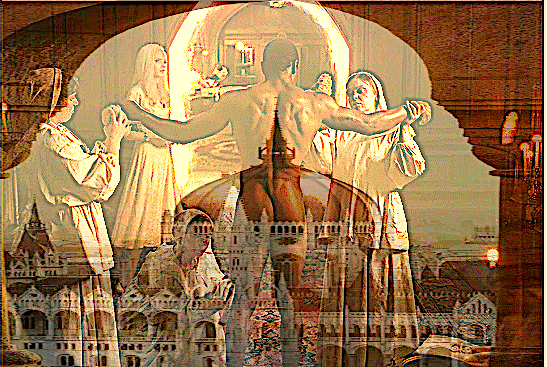Gnosis in Sacred Design and Architecture: Exploring Contemporary Artists' Works
Gnosis holds a significant place often associated with spiritual knowledge & inner enlightenment, a guiding force in creation throughout history.

In sacred design and architecture, gnosis holds a significant place. Gnosis, often associated with spiritual, esoteric knowledge and inner enlightenment, has been a guiding force in creating sacred spaces throughout history. In contemporary times, we see this concept beautifully reflected in the works of various artists redefining sacred design and architecture.
Contemporary artists harness the power of sacred geometry, symbolism, and spirituality to create awe-inspiring spaces that evoke a sense of transcendence and connection to the divine. With their innovative approaches, these artists merge traditional principles with modern techniques to shape environments with a deep spiritual resonance.

One prominent aspect of gnosis in contemporary sacred design is sacred geometry. Artists are exploring the ancient mathematical principles that underlie the creation of sacred spaces, such as the golden ratio, the Fibonacci sequence, and the Flower of Life. By incorporating these geometric patterns into their designs, artists aim to create harmonious and balanced environments that resonate with a sense of cosmic order.



Symbolism also plays a vital role in contemporary sacred design and architecture. Artists draw inspiration from various spiritual traditions, mythology, and cultural heritage to infuse their creations with profound symbolism. These symbols act as gateways to deeper understanding and connection, inviting viewers to explore the layers of meaning embedded within the design. From intricate mandalas to sacred symbols like the Tree of Life or the lotus flower, each element in the design carries its significance and contributes to the overall spiritual experience.
Another significant aspect of contemporary sacred design is the integration of spirituality and sustainability. Artists are increasingly conscious of the shift in modern morals and values, reflected in the new contemporary artworks immerging from the creative, innovative minds that are part of the consciousness reflected; in their designs. This First Nations-inspired approach aligns with the Earth's sacredness and fosters a reverence for the natural world. By creating environmentally friendly sacred spaces, artists honor the principles of gnosis and contribute to the planet's well-being.
Contemporary artists also explore the transformative power of light and sound in sacred design. By utilizing innovative lighting techniques, artists create ethereal atmospheres that evoke a sense of the transcendent. The interplay of light, shadow, and vibrant colors add depth and dimension to the sacred space, creating a visually captivating experience. Similarly, integrating sound elements, such as chanting or sacred music, enhances the spiritual ambiance, immersing visitors in a multi sensory journey.

Contemporary artists aim to evoke a sense of awe, wonder, and spiritual contemplation through their works. These sacred spaces act as portals to higher states of consciousness and invite individuals to explore their inner depths. By intertwining traditional wisdom with contemporary aesthetics and techniques, artists bridge the gap between the ancient and the modern, offering a new interpretation of gnosis in the context of sacred design and architecture.
In conclusion, contemporary artists are redefining sacred design and architecture by infusing their creations with the essence of gnosis. Through sacred geometry, symbolism, sustainable practices, light, and sound, these artists create immersive spaces that inspire spiritual contemplation and connection. Their works transmit inner knowledge and remind us of our world's profound beauty and sacredness. As we continue to witness the evolution of contemporary sacred design, we are reminded of the timeless wisdom embedded within these creations and the potential they hold to elevate our consciousness and deepen our spiritual experiences.

FAQ:
What is the role of gnosis in contemporary sacred design and architecture?
Gnosis in contemporary sacred design and architecture embodies spiritual and esoteric knowledge that guides the creation of spaces resonating with divine connection. Artists use sacred geometry and symbolism to create environments that reflect cosmic order and inner enlightenment.
How do contemporary artists integrate sacred geometry into their works?
Contemporary artists use sacred geometry, such as the golden ratio and the Fibonacci sequence, to bring harmony and balance to sacred spaces. These geometric patterns are designed to resonate with a cosmic order, enhancing the spiritual quality of the environment.
Why is symbolism important in modern sacred design?
Symbolism in sacred design acts as a bridge to deeper spiritual understanding and connection. Artists incorporate symbols from various spiritual traditions, like the Tree of Life or mandalas, to convey profound meanings and invite viewers into a journey of contemplation and enlightenment.
How do contemporary sacred spaces evoke a sense of transcendence?
Artists use light and sound to transform sacred spaces into ethereal experiences, employing techniques that create immersive atmospheres. These elements, combined with vibrant colors and innovative lighting, transport visitors into a journey of spiritual and sensory discovery.
What is the importance of sustainability in contemporary sacred design?
Sustainability in sacred design reflects a reverence for the natural world, aligning with spiritual principles. By integrating eco-friendly practices, artists honor the sacredness of the Earth and contribute positively to environmental stewardship, which complements the spiritual intent of gnosis.
How do contemporary artists combine traditional wisdom with modern techniques?
Contemporary artists merge age-old sacred principles with modern aesthetics to redefine sacred design. By doing so, they create spaces that honor traditional wisdom while offering new interpretations of gnosis, bridging the gap between the ancient and the current.
How does the focus on gnosis influence the Canadian contemporary sacred art scene?
Gnosis directs the Canadian contemporary sacred art scene by infusing deep spiritual knowledge into artistic creations. This focus aligns with Canada's diverse spiritual heritage and encourages artists to create spaces that invite contemplation and spiritual elevation.

